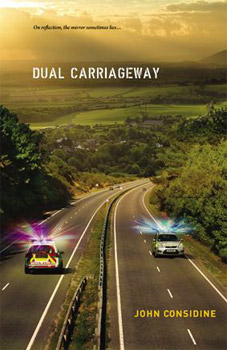Dual Carriageway

Dual Carriageway
Shane Willing has an identical twin brother, Barry. But why is it that Barry's life is not dogged by the same crippling misfortune as his twin's? But then, perhaps it is…
Separated by distance but sharing similar goals at work and at play, the off-duty hours of the brothers are spiced up in humorous and saucy situations which pepper the novel. But when a twist of fate simultaneously steps into both their lives does it set in motion the possibility of a new start- or is it déjà vu?
Dual Carriageway, is a fictional study of the unique relationships between twins – the implicit awareness, the shared chemistry and the peculiar differences.
Author, John Considine is a writer with a sharp eye and provides readers with a front row seat amid the turmoil of mounting disasters.
Dual Carriageway is a fascinating and often very funny exploration of sibling struggles and relationship reversals where all is not what it appears to be.
Melbourne-based John Considine is a teacher of biology and mathematics. He is the author of a number of works of fiction, some previously unpublished, and has been a contributor to non-fiction publications, including Australasian Poultry and Grass Roots magazines. The author has also produced a series of entertaining travel reports written under the name John de Dijon. He has co-written several dramatic works for theatre groups and is a musician.
Dual Carriageway
Sid Harta
Author: John Considine
ISBN: 9781922086303
RRP: $24.95
Interview with John Considine
Question: What inspired you to write Dual Carriageway?
John Considine: Having worked as a teacher of senior biology for several decades, the nature and function of DNA has always intrigued me. As a writer, I am well aware of the often peculiar nature of the genetic material. Identical twins are, in effect, clones. They are the only human clones that have ever existed. Dual Carriageway is a mischievous novel. It is a story of troublesome twists and turns. For a writer, identical twins, and the problems associated with dual identities, present unique opportunities to explore characters and develop story lines which can be humorous, but also thought-provoking. I'm pleased with the way the story has evolved and I encourage readers to follow the protagonist, Shane Willing, and his twin brother, Barry, as they face the challenges of new careers and new relationships along rocky roads which seem to have more convergences than perhaps they might like.
Question: Although fictional, how many years of research went into Dual Carriageway?
John Considine: Indeed, Dual Carriageway is a work of fiction. Once the seeds of the story had germinated in my mind, its writing proceeded quickly and smoothly - arriving at its birth some nine months after conception. Many aspects of the story required confirmation in relation to their scientific aspects. My years as a teacher assisted greatly in this regard, but a study of on-going developments in a field of knowledge which is expanding as rapidly as genetic technologies, was essential in order to present a story which is neat and credible, but which also conforms to facts as they are currently understood. Having said that, Dual Carriageway is a simple read. There are no heavy scientific notions to wade through here. It is a novel which is accessible to all readers.
Question: How do twins differ from other siblings?
John Considine: Dual Carriageway is a story which revolves around identical twins. Twins of this type have developed from a single fertilised ovum. Within the first few days of its development, the new zygote, enclosed within a blastocyst, comprises a clump of dividing cells. If these cells divide into two distinct clumps at this stage - prior to any differentiation of cell types - then both clumps may continue to develop as growing humans. Under these circumstances, the two embryos may or may not implant separately in the uterus, depending on the timing of the split. Such twins have developed from a single instance of fertilisation, so will contain identical DNA. Differences which eventually arise between these individuals will be due to a combination of genetic mutations, variations in environmental influences and the effect of epigenetic factors which control gene expression. Biovular twins arise when two ova are fertilised at the time of a single ovulation and both develop in the uterus with separate placental attachments. They are delivered at birth as either the same or different gender. Apart from this peculiar aspect, biovular twins are usually no more alike than other siblings.
Identical twins can experience a range of unique social problems. It is not unusual for them to be troubled by their dual identity... they may face questions of ambivalence: Who am I? as opposed to Who are we? These problems often stem from they way in which they are treated by others who might be a little too quick to group them as a single entity. Many people unconsciously add to the frustrations of twins through careless comments or gestures: Where's you sister? Why isn't she with you? Hey, great dress. Did your sister get one too? How come you only got 60% for the test and your sister got 85%? I only bought one birthday card - it's for both of you. Careful guidance by parents and teachers can usually help twins to diversify their own lives naturally by encouraging individual interests and skills.
Question: What's next for you, in regards to writing?
John Considine: I usually have a number of ideas floating about in my head. At this stage, nothing specific is being developed, but perhaps I may confide in you... I have been keeping a bit of an eye on the next generation of Wilchesterians... and I'm very sorry to have to tell you that their behaviour doesn't seem to be any better than that of their parents. Tsk. Honestly, will these people never learn?
MORE



